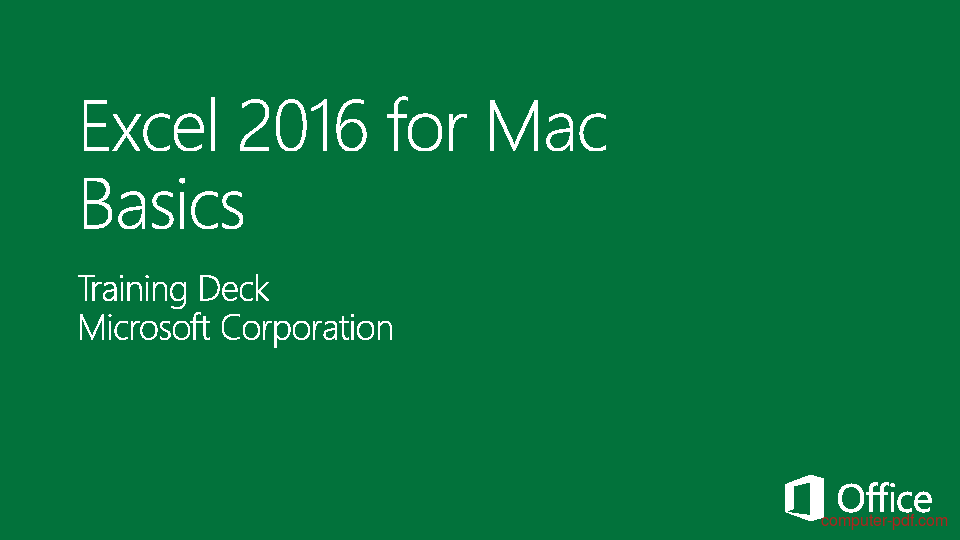

- #Excel for mac 2016 tutorial how to#
- #Excel for mac 2016 tutorial update#
- #Excel for mac 2016 tutorial windows#
With this update, you can also create and manage Power Query queries in your workbook using VBA.
#Excel for mac 2016 tutorial update#
Click the Data tab on the ribbon > Connections > select the desired connection > and click Change File Path button to update it. Please note that upon the first time you try to refresh your workbook queries, you may need to update the location of the data source so that it works on your Mac.
#Excel for mac 2016 tutorial how to#
If you are running an earlier version, find out how to update your Office for Mac.

The new functionality is live for all Office 365 subscribers in Excel for Mac running version 16.29 (19090802) and later. In this release, you can refresh your Power Query queries on Mac from Text, CSV, XLSX, XML and JSON files, and you can author queries with VBA. This is by far the most popular idea on Excel UserVoice under Excel for Mac category. Today, we are excited to announce the first step in a journey to support Power Query in Excel for Mac. These tools, based on Power Query technology, enable you to easily connect, combine, and shape data coming from a variety of sources. We'll have a complete list of changes on the Exceljet website.Excel 2016 for Windows introduced a powerful set of Get & Transform Data tools.

One last note: with the introduction of Excel 2016 on the Mac, Microsoft has started to adjust Mac shortcuts to be more in line with Windows.
:max_bytes(150000):strip_icc()/015-add-macros-in-excel-4176395-919ab716d26d4170af4bada4469a36f7.jpg)
The shortcut to toggle absolute and relative references is F4 in Windows, and Command T on a Mac.įor a complete list of shortcuts, see our side-by-side list on the Exceljet website.
#Excel for mac 2016 tutorial windows#
There is no equivalent on the Mac.įinally, the fifth difference on a Mac is that some Excel shortcuts are just different.įor example, the shortcut for Edit Cell, in Windows is F2 and on a Mac, it's Control + U. Ribbon shortcuts on Windows are based on so called accelerator keys, and always begin with Alt. The fourth difference on Macs is the lack of ribbon shortcuts. If you're using an extended keyboard on a Mac, you don't need to worry about this. But, once you understand the substitutions, the shortcut make more sense. This can make certain shortcuts seem complicated on a Mac, because you need to use substitutions for these keys. Personally, I like using the function keys to control the computer, so I leave this setting alone, and just the fn key when needed in Excel.Ī third difference on Macs is that certain keys like Home, End, backspace, page up, and page down, and so on, are missing, unless you're using an extended keyboard. You can actually change this behavior, by unchecking a checkbox under System Preferences.īut, if you do this, you won't be able to use function keys for things like Brightness, unless you hold down the fn key. So, for example, to use the F9 key to evaluate a formula, you'll need to use fn + F9 You'll find this key in the lower left on your keyboard. To make function keys operate as you expect in Excel, you need to hold the function or fn key. Second, function keys behave differently on a Mac.įunction keys sit at the top of the keyboard and are labeled F1 to F12 on standard keyboards and F1 to F15 on extended keyboards.īy default, Function keys on a Mac control the computer itself, things like screen brightness, volume, video pause and play, and so on. On a Mac, you'll see these symbols in menus across all applications, so they're not specific to Excel. Here's a list of those symbols and the keys they represent. Here are the 5 key differences you need to be aware of.įirst, many shortcut keys on the Mac are often abbreviated as symbols. But it may not feel that way, especially if you come from a Windows background. In general, Excel shortcuts on the Mac are more similar than different from Windows shortcuts. In this video, we'll talk about using Excel shortcuts on the Mac.


 0 kommentar(er)
0 kommentar(er)
